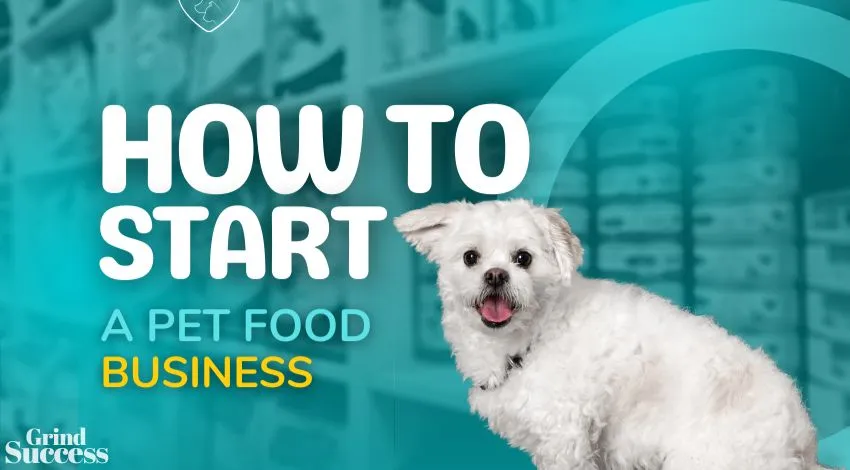How to Start a Successful Pet Food Business

The pet food industry is growing rapidly, with an increasing number of people choosing to own pets and looking for high-quality food options for their furry friends.
If you have a passion for pets and are interested in starting your own business, a pet food business can be a profitable venture. However, starting any business requires careful planning and execution to ensure success.
In this blog, we’ll provide a comprehensive guide on how to start a pet food business, from researching and planning to market and sales.
Whether you want to create organic, all-natural pet food or focus on a specific type of pet, this guide will provide valuable insights on how to make your business a success.
In recent years, more people have been adopting pets and treating them as members of the family. As a result, pet owners are becoming increasingly concerned about the quality of the food they feed their pets.
They are looking for high-quality, nutritious options that meet their pets’ specific dietary needs. This trend has created a demand for specialty pet foods, such as organic, all-natural, grain-free, and limited-ingredient diets.
The pet food industry is a lucrative and profitable market with significant potential for growth. With more people owning pets and spending money on pet food and treats, there is ample opportunity to tap into this market and build a successful business.
One of the reasons why the pet food industry is so profitable is that pet owners are willing to spend more money on high-quality pet food.
According to a survey by the APPA, 67% of pet owners say that they are willing to pay more for pet food that is of higher quality, and 53% of pet owners say that they are willing to pay more for all-natural or organic pet food.
Table of Contents
Research and Planning
Research and planning are crucial steps to starting a successful pet food business. It’s important to identify your target market and determine the type of pet food you want to sell, as well as study the competition and develop a comprehensive business plan.
Additionally, determining the startup costs, identifying potential suppliers, and developing a manufacturing process that ensures consistency and quality are key components of successful research and planning.
By taking the time to carefully research and plan your pet food business, you can establish a strong foundation and increase your chances of success in the industry.
1. Identify the target market
Identifying your target market is a critical step in starting a pet food business. Knowing who your customers are will help you tailor your products and marketing strategies to meet their specific needs and preferences.
Here are some tips to identify your target market:
By identifying your target market, you can create products that meet their needs and preferences, tailor your marketing strategies to reach them effectively, and build a loyal customer base for your pet food business.
2. Determine the type of pet food to sell
When determining the type of pet food to sell, it’s important to consider factors such as market demand and nutritional value.
Researching the market demand for different types of pet food can help you identify which types of pet food are in high demand and have the potential for growth.
Additionally, considering the nutritional value of the pet food you offer can help you differentiate your products from competitors and attract health-conscious pet owners.
You may also want to consider offering specialty diets for pets with specific dietary needs, such as limited-ingredient or grain-free diets.
By carefully selecting the type of pet food to sell, you can create products that meet the needs and preferences of your target market and position your business for success in the pet food industry.
3. Study the competition
Studying the competition is crucial to understand the market and positioning your pet food business for success.
Identifying your competitors and analyzing their products, pricing, marketing strategies, and customer base can provide valuable insights into what works and what doesn’t.
You can start by identifying other pet food businesses in your area or industry that offer similar products or target the same market.
Then, conduct market research, visit their websites and social media pages, attend trade shows or events, and even try their products to understand their strengths and weaknesses.
By analyzing your competitors’ strategies, you can identify opportunities to differentiate your products, stand out in the market, and attract new customers.
4. Develop a business plan
Developing a comprehensive business plan is crucial to ensure the success of your pet food business. It should include an executive summary, market analysis, description of products and services, marketing strategies, and financial projections.
Conducting market research and analyzing the industry and competitors can help you identify opportunities and challenges to develop a realistic and effective business plan.
A well-crafted business plan can also help you secure funding from investors or lenders and provide a roadmap to measure your progress and adjust your strategies accordingly.
By taking the time to develop a solid business plan, you can increase your chances of success in the competitive pet food industry.
Legal and Regulatory Requirements
Complying with legal and regulatory requirements is critical to avoid penalties and maintain the safety and quality of your pet food products.
To start a pet food business, you may need to obtain various licenses and permits, such as a business license and pet food manufacturing permit, depending on your location.
You also need to comply with food safety regulations, including the FSMA and GMPs, which require proper handling, storage, and labeling of pet food products.
Other regulations may include registration with the FDA, compliance with state labeling requirements, and adherence to pet food ingredient restrictions.
It’s essential to work with legal and regulatory experts to ensure that your pet food business is fully compliant with all applicable regulations and standards.
By complying with legal and regulatory requirements, you can establish a positive reputation and build trust with your customers, ultimately contributing to the long-term success of your pet food business.
1. Obtain necessary permits and licenses
Obtaining the necessary permits and licenses is a crucial step to ensure that your pet food business operates legally and meets all regulatory requirements. Depending on your location, you may need to obtain a business license to operate your pet food business.
If you plan to manufacture pet food products, you may also need to obtain a food establishment permit to ensure compliance with food safety regulations.
Additionally, you may need to register your facility with the FDA and obtain a pet food manufacturing permit. It’s important to research and understand the specific requirements in your state or jurisdiction and ensure that you have all the necessary permits and licenses before starting your pet food business.
By obtaining the necessary permits and licenses, you can operate legally, protect the health and safety of pets, and establish a solid foundation for your business.
2. Meet FDA regulations for pet food manufacturing and labeling
Meeting FDA regulations for pet food manufacturing and labeling is crucial to ensure the safety and quality of pet food products. In addition to sourcing and handling safe ingredients, it’s important to adhere to GMPs for pet food manufacturing.
This includes proper sanitation, hygiene, and processing to prevent contamination and ensure consistency in the final product.
Additionally, pet food labeling must meet FDA requirements, including a proper listing of ingredients, guaranteed analysis, and appropriate nutritional claims.
Proper labeling can help pet owners make informed decisions about the products they purchase for their pets.
It’s essential to work with legal and regulatory experts to ensure that your pet food manufacturing and labeling practices comply with all applicable regulations and standards.
By meeting FDA regulations, you can establish trust with your customers, ensure the safety and quality of your products, and ultimately contribute to the long-term success of your pet food business.
3. Comply with state and local regulations
Complying with state and local regulations is crucial for a pet food business to operate legally and avoid penalties. Depending on your location, you may need to register your business with the state or obtain additional licenses.
Additionally, states may have specific labeling requirements that differ from FDA regulations. For example, some states require specific disclosures about certain ingredients, such as “mechanically separated meat.”
You’ll also need to comply with any state-specific ingredient restrictions or bans. Working with a regulatory expert can help you understand the specific requirements in your state and ensure compliance.
By complying with state and local regulations, you can avoid legal issues and ensure the safety and quality of your pet food products.
pet accessories
Pet accessories are products designed to enhance the lives of pets and their owners. They can range from practical items like collars and leashes to more decorative items like toys and clothing.
Here are some popular types of pet accessories:
Pet accessories can be sold in pet stores, online, or through other retail channels. When developing a pet accessory business, it’s important to identify a unique product offering and develop a strong brand identity.
By creating high-quality, innovative products that meet the needs and desires of pet owners, you can build a successful pet accessory business and make a positive impact on the lives of pets and their owners.
Sourcing Ingredients
Sourcing high-quality ingredients is essential for a successful pet food business.
Here are some key considerations when sourcing ingredients:
By sourcing high-quality, safe, and sustainable ingredients, you can create pet food products that are nutritious, delicious, and meet the needs of today’s conscientious pet owners.
Production and Packaging
Choosing the right production and packaging strategies is crucial when starting a pet food business. Depending on your resources and goals, you may choose to produce the food in-house or outsource to a contract manufacturer.
Regardless of which option you choose, establishing quality control measures and adhering to regulatory requirements is essential for ensuring a safe and nutritious product.
Additionally, selecting appropriate packaging and storage solutions, as well as implementing cost control measures, will help to maintain the quality of the product and keep the business profitable.
With careful planning and execution, you can develop and deliver a high-quality pet food product that meets the needs of your target market.
Marketing and Sales
Marketing and sales are two important aspects of business that are closely related but distinct. Marketing is the process of creating, communicating, delivering, and exchanging offerings that have value for customers, clients, partners, and society at large.
It involves understanding and meeting the needs and wants of customers through market research, segmentation, targeting, positioning, and branding.
Marketing also includes advertising, promotion, public relations, and other communication efforts aimed at building brand awareness, generating leads, and driving sales.
Sales, on the other hand, is the process of identifying, qualifying, and converting prospects into paying customers.
It involves building relationships with potential customers, understanding their needs and preferences, and convincing them to buy the products or services offered.
Sales can be done through various channels, such as face-to-face meetings, phone calls, email, social media, and e-commerce platforms.
Marketing and sales are interdependent and complementary functions. Effective marketing can help create demand for products or services and generate leads for sales teams to follow up on.
Sales teams, in turn, can provide feedback to marketing on what works and what doesn’t in terms of messaging, pricing, features, and customer preferences. By working together, marketing and sales can increase revenue, customer loyalty, and brand equity.
1. Create a brand identity
Choosing a name that reflects your brand’s values and personality is a key component of creating a strong brand identity. It should be memorable and easy to pronounce, and ideally, it should also be available as a domain name and on social media platforms.
Once you have a name, you can begin developing a visual identity that includes a logo, color palette, typography, and imagery. These elements should be consistent across all marketing materials, from your website to your social media profiles to your packaging.
You should also develop a brand voice and tone that reflects your brand’s personality and resonates with your target audience. This includes writing style, messaging, and the language you use to communicate with your customers.
Finally, you should consistently apply your brand identity across all touchpoints to create a cohesive and recognizable brand experience for your customers. By creating a strong brand identity, you can differentiate your brand, build brand awareness, and create customer loyalty.
2. Develop a marketing strategy
Developing a strong marketing strategy is essential for promoting a pet food business and attracting customers. Begin by defining your target market and developing a brand identity that resonates with them.
Use social media, partner with pet stores and veterinarians, attend trade shows, and offer promotions to build brand awareness and attract new customers. Collect and use customer feedback to continually improve your product and marketing strategy.
With a focused and effective marketing strategy, you can build a loyal customer base and grow your pet food business over time.
3. Establish relationships with retailers
Establishing relationships with retailers is crucial for growing a pet food business and increasing distribution.
Identify potential retailers, create a pitch highlighting the benefits of your product, negotiate terms, and maintain regular communication to provide ongoing support.
Analyze sales data to understand which retailers are performing well and adjust strategies as needed. By building strong relationships with retailers, you can expand distribution and reach a wider audience of potential customers, ultimately growing your pet food business over time.
4. Consider online sales channels
Incorporating online sales channels can be a powerful way to grow a pet food business and reach new customers.
Choose an e-commerce platform, optimize your website, leverage social media, offer promotions and discounts, partner with influencers, and analyze sales data to continually refine your strategy.
By taking advantage of these online sales channels, you can expand distribution and attract new customers to grow your pet food business.
Funding and Financing
Funding and financing are essential components of starting and growing a pet food business.
Here are some key options to consider:
When considering funding and financing options, be sure to carefully evaluate the costs and benefits of each approach, and choose the option that aligns with your business goals and values.
With the right funding in place, you can build a solid foundation for your pet food business and achieve long-term success.
Conclusion
In conclusion, starting a pet food business requires careful planning and execution. It’s important to conduct thorough market research, develop a unique product, and create a strong brand identity.
Production and packaging, developing a marketing strategy, establishing relationships with retailers, and considering online sales channels are all key components of growing a successful pet food business.
Funding and financing options can help provide the resources needed to start and scale the business. With the right combination of these factors and a commitment to quality and customer satisfaction, you can build a thriving pet food business and make a positive impact on the lives of pets and their owners.
Author Bio:
John Calvin is an experienced pet food marketer with a passion for improving the lives of pets and their owners. With over 10 years of experience in the pet food industry, John has developed a deep understanding of the market and the needs of pet owners.
This post was proofread by Grammarly. Try it – It’s Free!
Millions trust Grammarly’s free writing app to make their online writing clear and effective. Getting started is simple
Email, SMS, and more — Klaviyo brings your marketing all together, fueling growth without burning through time and resources.
Deliver more relevant email and text messages — powered by your data. Klaviyo helps you turn one-time buyers into repeat customers with all the power of an enterprise solution and none of the complexity.



![How To Start A Podcast Business in 12 Steps [2024] How To Start A Podcast Business in 12 Steps [2024]](https://grindsuccess.com/wp-content/uploads/2022/12/How-To-Start-A-Podcast-Business.webp)


